FORGONE LUBLIN “ALBUM OF LUBLIN REGION” BY ADAM LERUE
Album Lubelskie (Album of Lublin Region) published between 1857 and 1859 in the Warsaw Lithographic Studio of Adolf Pecq and Co.
Album Lubelskie (Album of Lublin Region) published between 1857 and 1859 in the Warsaw Lithographic Studio of Adolf Pecq and Co. is a valuable source for the iconography of Lublin and the region. It consists of two parts. The first one included 16 landscapes of Lublin, reprinted in 1857, inserted into 4 volumes. The images present the most important monuments of Lublin. The originator of the picturesque, lithographic work was Adam Lerue who came from Lublin Region. The graphics, based on the drawings drafted by him, were made by two lithographer-artists: Juliusz Cegliński (14 landscapes) and Władysław Walkiewicz (2 landscapes).
Adam Lerue (1825–1863) – illustrator, painter and lithographer, one of the most distinguished artists in the process of inventorying Polish monuments. As a student of the Warsaw School of Fine Arts he worked in the summer of 1846 for the Delegation, chaired by Kazimierz Stronczyński, describing the ancient monuments in the Kingdom of Poland. Between 1850 and 1853 Lerue took part in artistic travels with the Delegation to i.e. Lublin Governorate, making drawings and watercolour views of valuable artefacts.
Julian Cegliński (1827–1910) – painter, graphic artist. In 1844 – 1850 he studied at the Warsaw School of Fine Arts. He went on artistic tours around the country. He worked at zincographic plants of the Bank of Poland in Warsaw and lithographic studios of Adolf Pecq, Maksymilian Fajans and Adam Dzwonkowski. He co-operated with “Tygodnik Ilustrowany” (“The Illustrated Weekly”). He co-created Towarzystwo Zachęty Sztuk Pięknych (Society for Fine Arts Encouragement).
Władysław Walkiewicz (1833–1900) – drawer, illustrator and lithographe Student of the Faculty of Painting at the School of Fine Arts in Warsaw. Co-worker of Adolf Pecq, Adam Dzwonkowski, Józef Ring and Maksymilian Fajans, as well as the Lithography of the Bank of Poland. In 1870 he opened his own atelier. He captured the landscapes of cities – guberniyal Lublin, industrial Łódź and others. He was the author of portraits of famous Polish people and historical scenes.
Content: Renata Bartnik (Muzeum Lubelskie)
Translation: Anna Miączewska (UMCS)
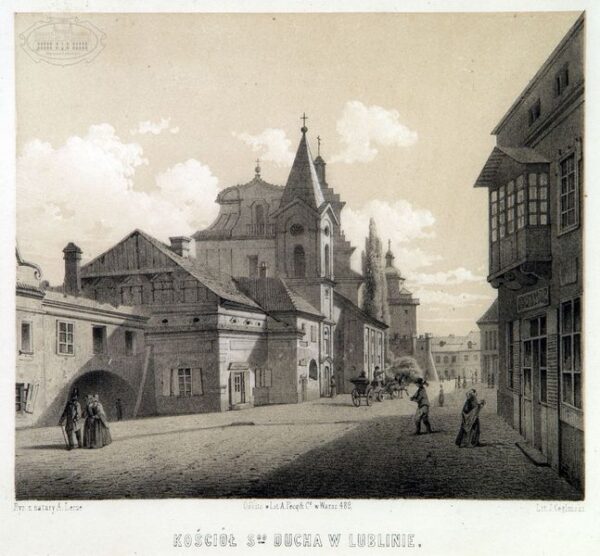 |
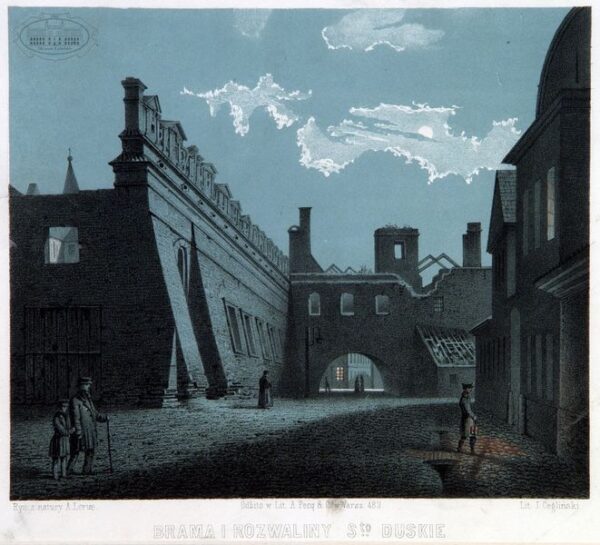 |
| 1. Church and hospital at Krakowskie Przedmieście,
lithography by J. Cegliński A fragment of Krakowskie Przedmieście with the Holy Spirit building complex (Church of the Holy Spirit together with a hospital commissioned in 1419, erected outside of the city walls). From the left: Brama Świętoduska (The Gate of the Holy Spirit; demolished in 1858), hospital buildings (dismantled in 1858) and the Church of the Holy Spirit with a façade topped with a baroque elevation and neogothic tower. Behind it, the outline of the tower of the New Town Hall. On the right, tenement houses of Krakowskie Przedmieście. In the background, Brama Krakowska (The Cracow Gate). |
2. The Gate and Hospital of the Holy Spirit,
lithography by J. Cegliński View of the Gate of the Holy Spirit and the remains of the Hospital of the Holy Spirit presented from Zielona Street; it shows the gate and hospital before the demolition in 1858. On the right side, tenement houses at Świętoduska Street (rebuilt nowadays). |
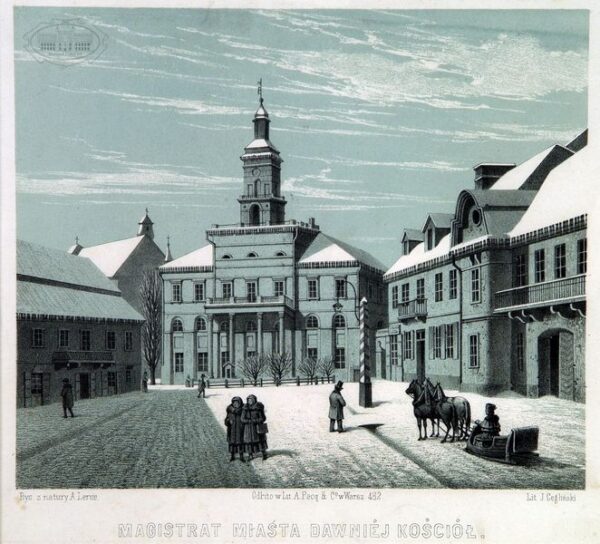 |
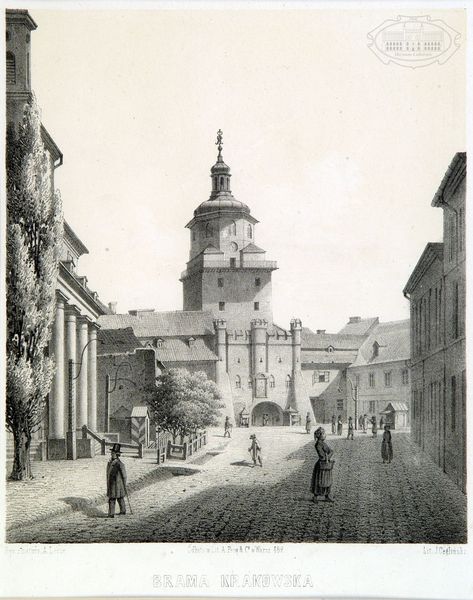 |
| 3. Magistrate of the city, former church,
lithography by J. Cegliński The New Town Hall erected in 1827–1828 on the remains of walls of the burnt-down church and monastery of the Discalced Carmelites (at present – Town Council of Lublin). View from the side of Królewska Street (former Korce, along which mansions and palaces were situated). In the foreground, a section of a wide street. To the left, a corner tenement house (at present without a cur roof, elevated by one floor). Behind the Town Hall is the silhouette of the Church of the Holy Spirit. |
4. The Cracow Gate,
lithography by J. Cegliński The Cracow Gate – the best preserved fragment of the medieval city walls – presented from the side of Krakowskie Przedmieście Street. The attention is drawn to the gallery with a balustrade and the clock face placed above, which are no longer in existence. To the left is a fragment of a monumental portico of the New Town Hall. Behind it, a tenement house demolished in 1939. To the right is a series of tenement houses along Krakowskie Przedmieście Street. |
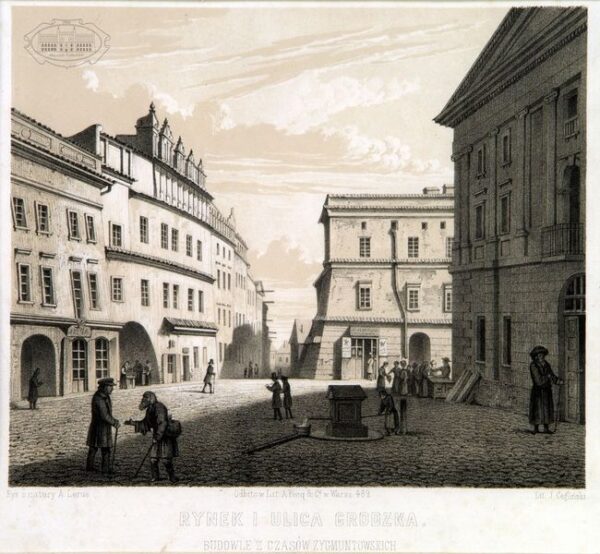 |
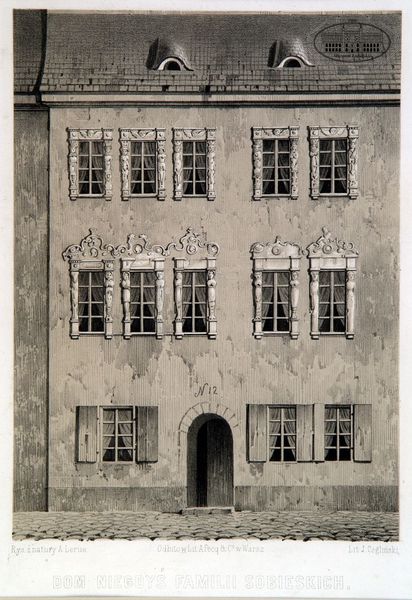 |
| 5. Market Square and Grodzka Street,
lithography by J. Cegliński A fragment of the Market Square – view towards Grodzka Street. To the right is the building of the Crown Tribunal (The Old Town Hall) in a classicistic style which it received after the reconstruction in 1781. In the background, a part of the façade of Cichoszewscy tenement house (at present – with an attic reconstructed in 1954). To the left, tenement houses of the northern frontage of the Market Square and Grodzka Street. In the cobbled square is a well demolished around 1931. |
6. Tenement House of Konopnica Family (the so-called Sobieski Family),
lithography by J. Cegliński The most beautiful and the most valuable tenement house in Lublin (Rynek 12). It is distinguished by its rich, high-quality sculptural decoration of the façade referring to the Dutch Mannerism. Built in the 15th century but thoroughly reconstructed in 1597–1614. In the first half of the 19th century its third floor was removed, but then once again built on in 1939 and topped with a pseudo-reconstruction of the attic. |
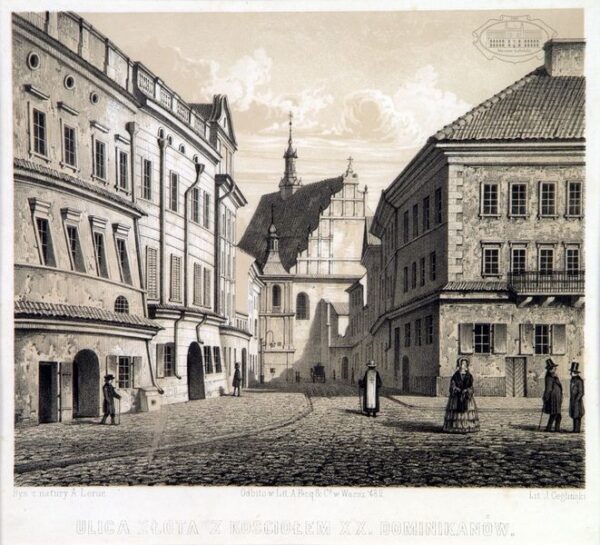 |
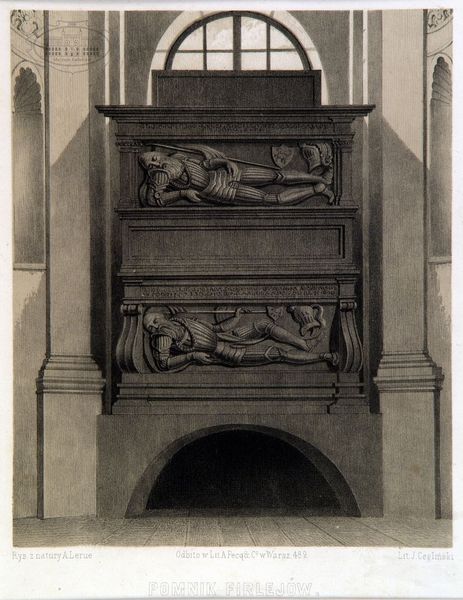 |
| 7. Złota Street and the Dominican Order Church,
lithography by J. Cegliński A fragment of the cobbled Market Square going into the narrow Złota Street (formerly Saint Stanislaus or Dominikańska Street) leading to the Dominican Order Church. To the left is a compact sequence of tenement houses with a tenement house by Złota Street 2, which at present has no top level. On the right is a fragment of the corner tenement house “Pode lwami” (“Under the Lions”; formerly with an attic decorated with the figures of lions). |
8. Funerary memorial of Piort and Mikołaj Firlej in the Dominican Order Church,
lithography by J. Cegliński The church and monastery of the Dominican Order belong to the oldest and most valuable terms of reference to sacral Lublin. The beginnings of the temple date back to the second half of the 13th century. Distinction should be given to the domed chapel of Saint Dominic (Firlej Chapel) with the renaissance tombstone of Mikołaj (died in 1526) and Piotr (died in 1553, Mikołaj’s son) Firlej, made in the workshop of Jan Mario Padovana in Cracow. The representatives of a prominent magnate family associated with Lublin region are immortalised in the position of semi-recumbent knights. |
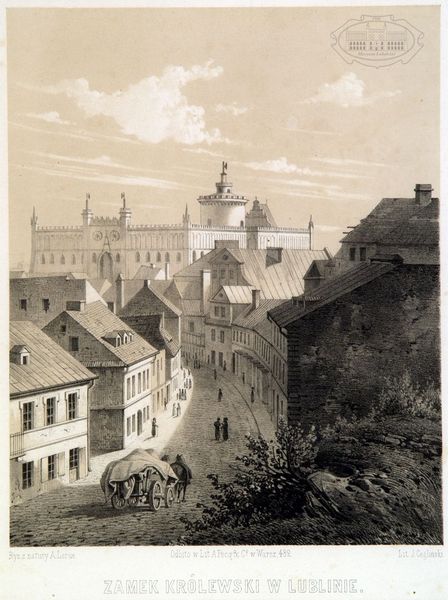 |
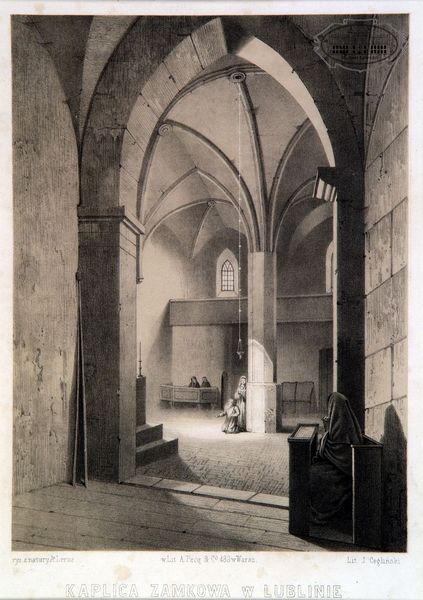 |
| 9. View of the Castle
from Kowalska Street, lithography by J. Cegliński The Castle Hill from the angle of the cobbled Kowalska Street with built-up tenement houses, seen from the side of Nowa Street (Lubartowska Street at present). In the background is the prison building erected in 1826 in the place of the former gothic castle from the mid-14th century. Above it is visible an upper part of the donjon (the oldest preserved Romanesque building in Lublin) and the late renaissance top level of the Holy Trinity Chapel (the most valuable monument in Lublin from the 14th century). |
10. The Holy Trinity Chapel at the Royal Castle,
lithography by J. Cegliński View of the interior of the gothic chapel with a central pillar in the nave, supporting the ribbed vault. By the western wall is a choir and below it, to the left, a small wall tower concealing the staircase. There are no longer existing benches (in the nave under the small wall tower and in the presbytery) and the floor cover (in the presbytery – made of stone slabs and in the nave – of brick). On the walls and the vault the famous Byzantine-Russian frescoes from 1418 are exposed. |
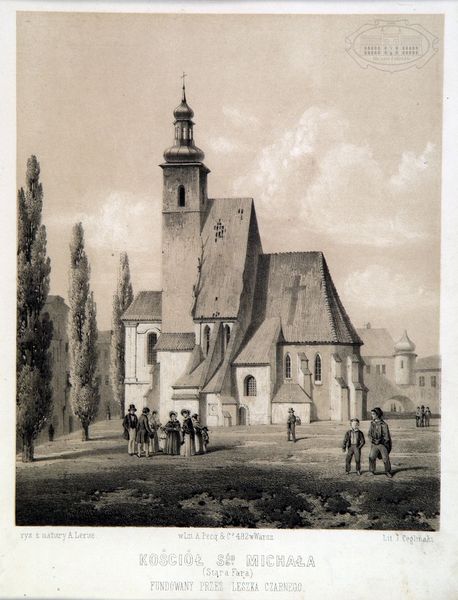 |
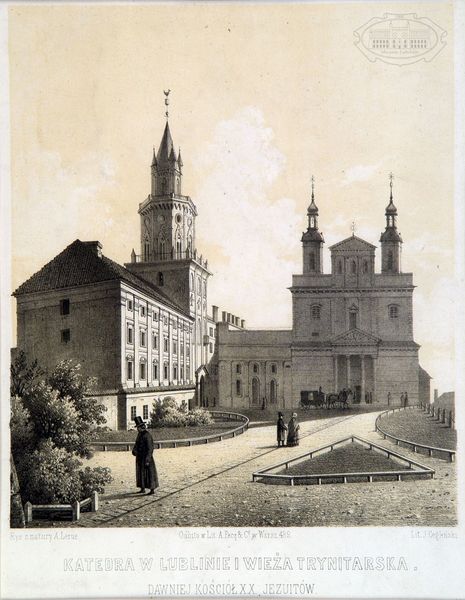 |
| 11. Collegiate Church of Saint Michael,
lithography by J. Cegliński View of the unpreserved parish church of Saint Michael the Archangel (situated in the oldest part of the Old Town, founded by Leszek the Black in 1282, demolished in the mid-19th century). In the background are buildings surrounding the church and Cekhaus – the tower in the city walls, in which harquebuses, bullets and gunpowder were kept. The image of the church was made in 1844. The baroque helmet with a lantern, visible on the lithography, no longer existed in 1844. It was most probably copied from a drawing kept by the Guberniyal Government. |
12. The Jesuits’ Church (Cathedral), Collegium, Schools and the so-called Trinitarian Tower,
lithography by J. Cegliński View of the post-Jesuit building complex which was being erected from 1586 onwards outside of the city walls. The church (the Cathedral from 1823), collegium and the neogothic so-called Trinitarian Tower are presented from the western side. While arranging the area in 1815, two wings of the Jesuit buildings were demolished and a square in front of the Cathedral was made. In 1845 the façade of the temple was reconstructed, changing the previous project of Antonio Corazzi into the four-column portico with a triangular pediment. |
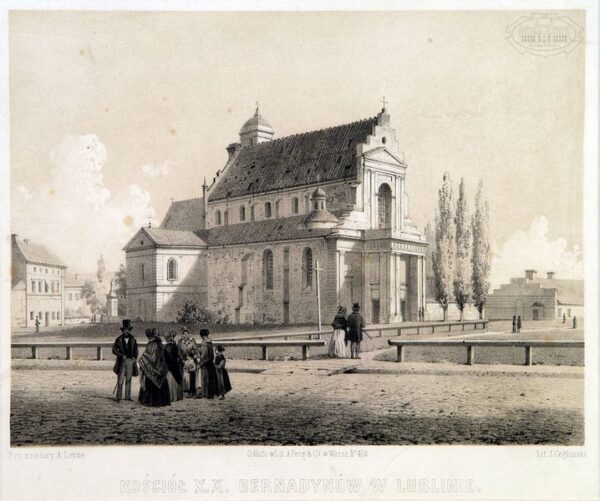 |
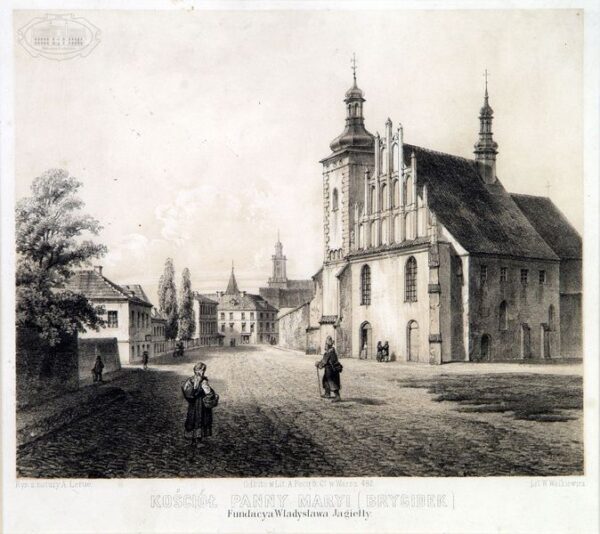 |
| 13. Bernardine Church,
lithography by J. Cegliński The post-Bernardine building complex, erected outside of the city walls, was being made from 1460 onwards. The present, late renaissance church, was erected in 1602–1607 after the reconstruction of the late gothic building. The classicistic façade from 1827 was remodelled between 1858 and 1860. In the background of the temple, the surrounding buildings are present. On the left, Bernardyńska Street, on the right – access to Tarłów Palace. In the foreground, a large square and a fragment of a market-place cobbled in 1838 in front of the church. It was named “Bernardine” in 1857. |
14. The Bridgettine Church of the Virgin Mary of Victory,
lithography by W. Walkiewicz View of the church erected together with the monastery in 1412–1426 outside of the city walls as a votive offering of King Władysław II Jagiełło after the victorious battle of Grunwald. At the beginning of the 19th century a street was widened in their vicinity and the Namiestnikowski Square was built and where fairs were later held (today’s square and the building of the Faculty of Pedagogy and Psychology of Maria Curie-Skłodowska University). The tower of the New Town Hall and the palace of Parys (Bernardyńska Street 3), built probably in the 17th century, are visible. |
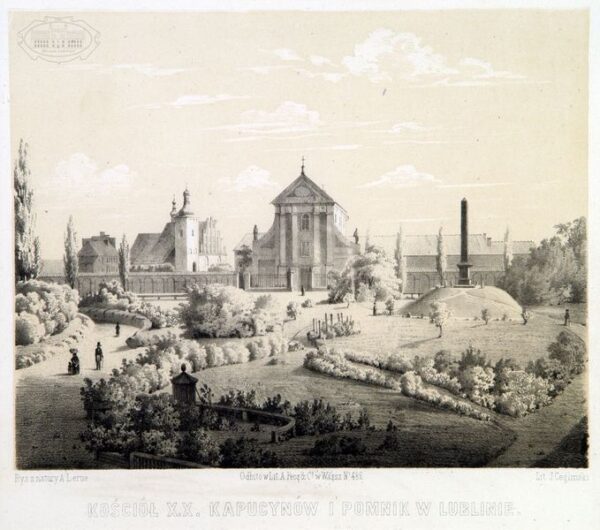 |
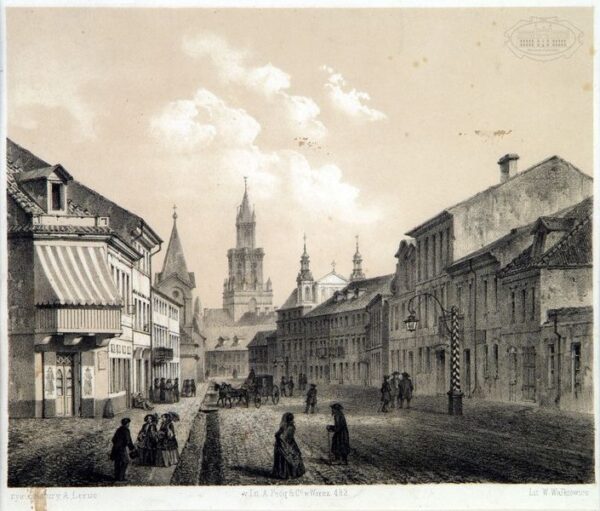 |
| 15. The Capuchins’ Building Complex and the Memorial of the Union of Lublin,
lithography by J. Cegliński View from the today’s Litewski Square to the Capuchins’ projects surrounded by a fence (erected in 1726–1733). The gardens of the monastery are presented to the left behind the monastic wall. In the background – the silhouette of the post-Bridgettine Church. In the foreground, a square with communication networks and the memorial of the Union of Lublin. The obelisk, placed on a mound, was set in 1826 in the place of an earlier one which was demolished in 1819. Litewski Square (Lithuanian Square) has been acting as a new city centre of Lublin since the 19th century. Its name refers to the Lithuanian nobility who, in accordance with tradition, arrived for the parliament session and stationed here in 1569. |
16. Krakowskie Przedmieście in Lublin,
lithography by W. Walkiewicz Krakowskie Przedmieście, the main street of Lublin, with the so-called Trinitarian Tower in the distant perspective. On the right, a series of tenement houses of various height, behind which the top level and towers of the Cathedral are visible. On the left, the so-called tenement house of Magierski and Wilczyński with a recognisable awning above the shop, at the corner of Poczętkowska Street (today’s Staszica Street) and Krakowskie Przedmieście. |



